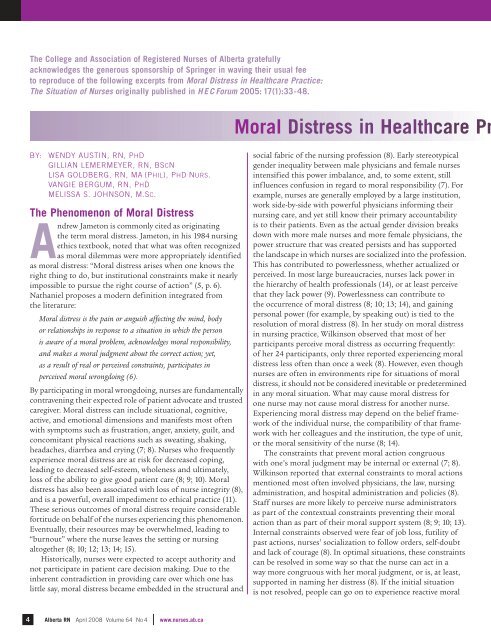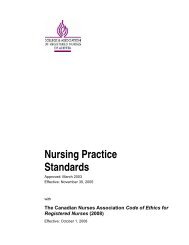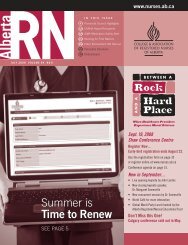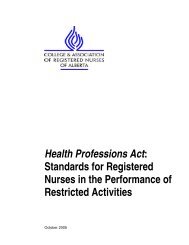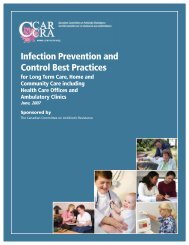I am a nurse. - College & Association of Registered Nurses of Alberta
I am a nurse. - College & Association of Registered Nurses of Alberta
I am a nurse. - College & Association of Registered Nurses of Alberta
You also want an ePaper? Increase the reach of your titles
YUMPU automatically turns print PDFs into web optimized ePapers that Google loves.
The <strong>College</strong> and <strong>Association</strong> <strong>of</strong> <strong>Registered</strong> <strong>Nurses</strong> <strong>of</strong> <strong>Alberta</strong> gratefully<br />
acknowledges the generous sponsorship <strong>of</strong> Springer in waving their usual fee<br />
to reproduce <strong>of</strong> the following excerpts from Moral Distress in Healthcare Practice:<br />
The Situation <strong>of</strong> <strong>Nurses</strong> originally published in H E C Forum 2005: 17(1):33-48.<br />
The Phenomenon <strong>of</strong> Moral Distress<br />
Andrew J<strong>am</strong>eton is commonly cited as originating<br />
the term moral distress. J<strong>am</strong>eton, in his 1984 nursing<br />
ethics textbook, noted that what was <strong>of</strong>ten recognized<br />
as moral dilemmas were more appropriately identified<br />
as moral distress: “Moral distress arises when one knows the<br />
right thing to do, but institutional constraints make it nearly<br />
impossible to pursue the right course <strong>of</strong> action” (5, p. 6).<br />
Nathaniel proposes a modern definition integrated from<br />
the literature:<br />
Moral distress is the pain or anguish affecting the mind, body<br />
or relationships in response to a situation in which the person<br />
is aware <strong>of</strong> a moral problem, acknowledges moral responsibility,<br />
and makes a moral judgment about the correct action; yet,<br />
as a result <strong>of</strong> real or perceived constraints, participates in<br />
perceived moral wrongdoing (6).<br />
By participating in moral wrongdoing, <strong>nurse</strong>s are fund<strong>am</strong>entally<br />
contravening their expected role <strong>of</strong> patient advocate and trusted<br />
caregiver. Moral distress can include situational, cognitive,<br />
active, and emotional dimensions and manifests most <strong>of</strong>ten<br />
with symptoms such as frustration, anger, anxiety, guilt, and<br />
concomitant physical reactions such as sweating, shaking,<br />
headaches, diarrhea and crying (7; 8). <strong>Nurses</strong> who frequently<br />
experience moral distress are at risk for decreased coping,<br />
leading to decreased self-esteem, wholeness and ultimately,<br />
loss <strong>of</strong> the ability to give good patient care (8; 9; 10). Moral<br />
distress has also been associated with loss <strong>of</strong> <strong>nurse</strong> integrity (8),<br />
and is a powerful, overall impediment to ethical practice (11).<br />
These serious outcomes <strong>of</strong> moral distress require considerable<br />
fortitude on behalf <strong>of</strong> the <strong>nurse</strong>s experiencing this phenomenon.<br />
Eventually, their resources may be overwhelmed, leading to<br />
“burnout” where the <strong>nurse</strong> leaves the setting or nursing<br />
altogether (8; 10; 12; 13; 14; 15).<br />
Historically, <strong>nurse</strong>s were expected to accept authority and<br />
not participate in patient care decision making. Due to the<br />
inherent contradiction in providing care over which one has<br />
little say, moral distress bec<strong>am</strong>e embedded in the structural and<br />
4<br />
BY: WENDY AUSTIN, RN, PHD<br />
GILLIAN LEMERMEYER, RN, BSCN<br />
LISA GOLDBERG, RN, MA (PHIL), PHD NURS.<br />
VANGIE BERGUM, RN, PHD<br />
MELISSA S. JOHNSON, M.SC.<br />
<strong>Alberta</strong> RN April 2008 Volume 64 No 4 www.<strong>nurse</strong>s.ab.ca<br />
Moral Distress in Healthcare Pr<br />
social fabric <strong>of</strong> the nursing pr<strong>of</strong>ession (8). Early stereotypical<br />
gender inequality between male physicians and female <strong>nurse</strong>s<br />
intensified this power imbalance, and, to some extent, still<br />
influences confusion in regard to moral responsibility (7). For<br />
ex<strong>am</strong>ple, <strong>nurse</strong>s are generally employed by a large institution,<br />
work side-by-side with powerful physicians informing their<br />
nursing care, and yet still know their primary accountability<br />
is to their patients. Even as the actual gender division breaks<br />
down with more male <strong>nurse</strong>s and more female physicians, the<br />
power structure that was created persists and has supported<br />
the landscape in which <strong>nurse</strong>s are socialized into the pr<strong>of</strong>ession.<br />
This has contributed to powerlessness, whether actualized or<br />
perceived. In most large bureaucracies, <strong>nurse</strong>s lack power in<br />
the hierarchy <strong>of</strong> health pr<strong>of</strong>essionals (14), or at least perceive<br />
that they lack power (9). Powerlessness can contribute to<br />
the occurrence <strong>of</strong> moral distress (8; 10; 13; 14), and gaining<br />
personal power (for ex<strong>am</strong>ple, by speaking out) is tied to the<br />
resolution <strong>of</strong> moral distress (8). In her study on moral distress<br />
in nursing practice, Wilkinson observed that most <strong>of</strong> her<br />
participants perceive moral distress as occurring frequently:<br />
<strong>of</strong> her 24 participants, only three reported experiencing moral<br />
distress less <strong>of</strong>ten than once a week (8). However, even though<br />
<strong>nurse</strong>s are <strong>of</strong>ten in environments ripe for situations <strong>of</strong> moral<br />
distress, it should not be considered inevitable or predetermined<br />
in any moral situation. What may cause moral distress for<br />
one <strong>nurse</strong> may not cause moral distress for another <strong>nurse</strong>.<br />
Experiencing moral distress may depend on the belief fr<strong>am</strong>ework<br />
<strong>of</strong> the individual <strong>nurse</strong>, the compatibility <strong>of</strong> that fr<strong>am</strong>ework<br />
with her colleagues and the institution, the type <strong>of</strong> unit,<br />
or the moral sensitivity <strong>of</strong> the <strong>nurse</strong> (8; 14).<br />
The constraints that prevent moral action congruous<br />
with one’s moral judgment may be internal or external (7; 8).<br />
Wilkinson reported that external constraints to moral actions<br />
mentioned most <strong>of</strong>ten involved physicians, the law, nursing<br />
administration, and hospital administration and policies (8).<br />
Staff <strong>nurse</strong>s are more likely to perceive <strong>nurse</strong> administrators<br />
as part <strong>of</strong> the contextual constraints preventing their moral<br />
action than as part <strong>of</strong> their moral support system (8; 9; 10; 13).<br />
Internal constraints observed were fear <strong>of</strong> job loss, futility <strong>of</strong><br />
past actions, <strong>nurse</strong>s’ socialization to follow orders, self-doubt<br />
and lack <strong>of</strong> courage (8). In optimal situations, these constraints<br />
can be resolved in some way so that the <strong>nurse</strong> can act in a<br />
way more congruous with her moral judgment, or is, at least,<br />
supported in n<strong>am</strong>ing her distress (8). If the initial situation<br />
is not resolved, people can go on to experience reactive moral


